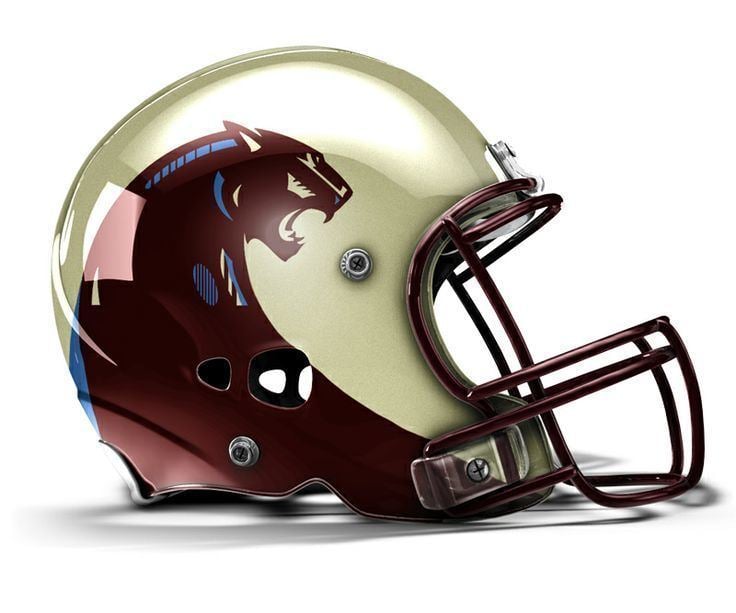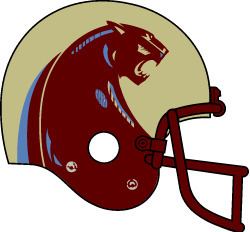League USFL Division Central Division Home field Silverdome | Conference Western Founded 1983 Based in Pontiac | |
Team colors Royal Plum, Champagne Silver, Light Blue, White | ||
1983 usfl championship game michigan panthers vs philadelphia stars
The Michigan Panthers were a professional American football team that played in the United States Football League (USFL) in the mid-1980s.
Contents
- 1983 usfl championship game michigan panthers vs philadelphia stars
- 1983 usfl divisional playoffs oakland invaders vs michigan panthers
- Team history
- 1983 season highlights
- 1984 season highlights
- Aftermath
- Single season leaders
- 1984
- References

1983 usfl divisional playoffs oakland invaders vs michigan panthers
Team history

The Michigan Panthers were named as a charter member of the United States Football League (USFL) on May 11, 1982.

A. Alfred Taubman, one of the nation's leading real estate developers, headed the ownership group that included Judge Peter B. Spivak and Max M. Fisher.

The Panthers named former CFL executive, Jim Spavital as their General Manager on August 26, 1982. Michigan then hired Jim Stanley as their Head Coach on November 18, 1982 after George Perles decided to coach at Michigan State. Stanley was head coach at Oklahoma State University. Stanley brought a wealth of coaching experience, with stops at SMU, UTEP, Oklahoma State, Navy, and on the professional level with the CFL's Winnipeg Blue Bombers, and NFL's New York Giants and Atlanta Falcons, mainly as an assistant coach. Stanley would be the club's only head coach. The coaching staffed was rounded out by Larry Coyer, Pete Rodriguez, and Dick Roach (Defensive coaches). George Dickson, Bob Leahy, and Kent Stephenson were the offensive coaches.
The Pontiac Silverdome (Cap. 80,638) was the home of the Panthers.
The USFL's first collegiate draft was held on January 4, 1983. The Panthers selected Wisconsin SS David Greenwood with their first round (10th overall) selection.
They also tabbed Michigan WR Anthony Carter in the USFL Territorial Draft – a process whereby USFL teams could protect up to 25 graduating seniors from a series of local universities. The Panthers had territorial rights to the University of Michigan, Michigan State, Eastern Michigan, Central Michigan and Northern Michigan. The Panthers used this draft to select two placekickers. One was Novo Bojovic, and the other was Michigan's Ali Haji-Sheikh. Sheikh spurned the Panthers to sign with the New York Giants of the NFL.
Michigan made a splash in signing some of the top young NCAA prospects in 1983 in Michigan WR Anthony Carter, Tulsa RB Ken Lacy, Wisconsin SS David Greenwood and QB Bobby Hebert of Northwestern State (La.). The Panthers also had a few key players with NFL experience. Tackle Ray Pinney and Tyrone McGriff had played for the Super Bowl Pittsburgh Steelers teams. Linebacker John Corker had played three seasons for the Houston Oilers. The Panthers also landed three former Cleveland Browns starters in running back Cleo Miller, defensive back Oliver Davis, and quarterback Mark Miller. The team also had former All-Pro punter Bob Grupp, who had played for the NFL's Kansas City Chiefs. However, Grupp had been a one season wonder in Kansas City, and after a few inconsistent weeks, he was released, and safety David Greenwood did double duty taking over as the team's punter. Future Buffalo Bills linebacker and children's book author Ray Bentley was also a Michigan Panther.
1983 season highlights
Michigan held its first training camp at City Island Stadium in Daytona Beach, Florida, sifting through over 75 players.
On Monday, March 7, 1983; the Panthers opened the season with a 9-7 win over the Birmingham Stallions at Legion Field in Birmingham, Alabama. This was the first professional football game ever broadcast on ESPN. Serbian kicker (via Central Michigan) Novo Bojovic kicked the winning field goal from 48 yards out in the waning moments.
The Panthers then dropped their next four contests, losing on March 12 to the Tampa Bay Bandits (19-7); Mar. 19 at home to the Oakland Invaders (33-27); Mar. 27 at the Washington Federals (22-16 in OT) and April 4 at home to the Denver Gold (29-21). Their slow start was attributed mostly due to a very porous offensive line that struggled to create holes or time for their offensive stars. Management addressed the issue by signing a bevy of experienced offensive linemen in OT Ray Pinney (Pittsburgh Steelers), OG Tyrone McGriff (Pittsburgh Steelers) and OG Thom Dornbrook (NY Giants). Dornbrook and McGriff would both make USFL all-league teams in 1983.
The Panthers had a six-game winning streak. Then, on May 23, they and the Birmingham Stallions were tied 20-20 in the fourth quarter. Michigan would have had the lead, but the extra point attempt was blocked. The game went into overtime and was won by Birmingham thanks to a 46-yard field goal by Stallions placekicker Scott Norwood.
The Panthers would bounce back with a 42-7 thrashing of the stellar Tampa Bay Bandits, coached by future Florida Gators head coach Steve Spurrier. After making those additions, and installing rookie Bobby Hebert as quarterback, the Panthers then won 11 of their next 13 contests and captured the Central Division championship with a 12-6 record.
In the playoffs, the Panthers hosted the Western Division champion Oakland Invaders before a USFL-record crowd of 60,237. The Panthers' decisive 37-21 victory vaulted them to the inaugural USFL Championship Game in Denver, Colorado.
On July 17, 1983, the Panthers captured the USFL's first championship with a 24-22 win over the Atlantic Division champion Philadelphia Stars. QB Bobby Hebert hit WR Anthony Carter on a 48-yard touchdown strike with 11:59 left in the fourth quarter for what proved to be the deciding score. Hebert was named MVP of the game, throwing for 319 yards and three touchdowns.
The Panthers wound up spending $6 million during the season—three times what USFL founder David Dixon recommended that a team spend in a single season. As a result, they had NFL-comparable talent at several positions.
1984 season highlights
The Panthers were expected to romp to another Central Division title in 1984. They were in a division with three expansion teams and a Chicago Blitz team that had swapped nearly all of its players with the last-place Arizona Wranglers. They initially didn't disappoint, sweeping their first six games. However, in the sixth game, a win over the expansion San Antonio Gunslingers, star receiver Anthony Carter broke his arm and was lost for the season. Without their chief offensive weapon the Panthers promptly went into a tailspin, losing eight of their next ten games (the Panthers' only wins in this stretch both came in overtime) to sink to an 8-8 record. Needing to win their last two games against Oklahoma and Chicago just to make the playoffs, Michigan did just that, finishing 10-8.
The first-round playoff game against the Los Angeles Express (in a less-than-tenth-filled Los Angeles Coliseum) turned out to be longest professional football game in history. The Panthers took a 21-13 lead in the fourth quarter, only to have future Hall of Famer Steve Young throw a touchdown pass, then personally score the two-point conversion to knot the game at 21 with 52 seconds remaining. The Panthers had chances to win the game in both the first and second overtimes, but normally reliable kicker Novo Bojovic missed field goals each time. Finally, in the third overtime, rookie Mel Gray (who would later play for the Detroit Lions) ran 24 yards to give LA a 27-21 victory, ending pro football's longest day after 93 minutes and 33 seconds of play time. (Gray's touchdown would prove to be painful for the young star—the force of the tackle at the end of the play broke his arm.) [1]
It turned out to be the Panthers' last game. After the 1984 season was over USFL owners, largely under the influence of New Jersey Generals owner Donald Trump and Chicago franchise owner Eddie Einhorn began talking seriously about moving to a fall schedule in 1986. While the Panthers had developed a loyal following, Taubman was a strong believer in the original spring football concept. He also had no desire to compete with the Detroit Lions, who were owned by his longtime friend William Clay Ford.
Taubman felt like the move was a foregone conclusion. As a result, after the merger between the Oakland Invaders and the Oklahoma Outlaws collapsed, Taubman quietly approached Invaders owner Tad Taube about a possible merger with his Panthers. When the league owners met to vote on moving to the fall, Taubman sent his son with a message for the commissioner—if the teams voted to move to the fall, the Panthers would merge with the Invaders, with the Invaders as the surviving team. When the vote to play in the fall passed, the Panthers and Invaders announced their merger, with Taubman as majority owner of the Invaders.
Aftermath
After the USFL received only $3 in its antitrust lawsuit against the NFL, on which it had staked its survival, the league suspended operations and never returned. The league's abandonment of the Detroit market was a major factor behind the adverse jury award.
The A-11 Football League (A11FL), a planned spring football league which had intended to start play in 2015, had announced its intention to revive the Michigan Panthers for one of its charter franchises.
Single season leaders
Rushing Yards: 1182 (1983), Ken Lacy
Receiving Yards: 1220 (1984), Derek Holloway
Passing Yards: 3368 (1984), Bobby Hebert
1984
1 – Longest game in professional football history.
